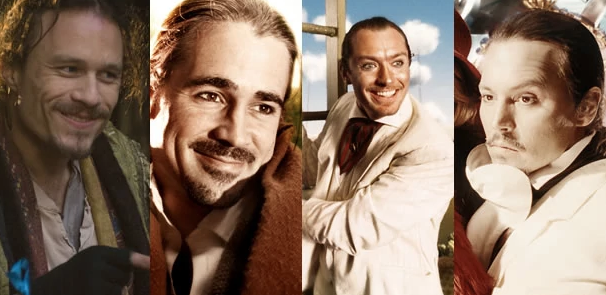Gilliam’s Gamble Pays off with “Imaginarium”
Posted by katy on 2/02/10 • Categorized as film
Terry Gilliam’s new film The Imaginarium of Dr. Parnassus, as many have now heard, almost never got finished. Like his doomed Don Quixote, the picture suffered major setbacks in the process of being made: the shocking death of its young star midway through filming, of its producer during post-production, and, amazingly, even a near-paralyzing accident in which Mr. Gilliam himself broke a vertebra. Unlike Quixote, though, Imaginarium managed to persevere–and Gilliam’s anxieties about the difficult births of his films are evident throughout the work.
Heath Ledger in his final role.
There is a scene in the film where, panicked to lose an audience which seemed certain moments earlier, the young player becomes brusque, frightening the potential volunteers until he finally throws one over his shoulder and hauls her into the Imaginarium by force. The scene could be a metaphor for the film itself: at times desperation seems to make it a bit careless–but that doesn’t mean wonders don’t await you in Imaginarium. The picture may be flawed, but the experience is still rewarding.
Gilliam himself has frequently alluded to the film being self-referential: it can be taken to stand for the angst of a filmmaker who may or may not have lost his relevance. The story concerns Dr. Parnassus (Christopher Plummer), a thousand-year-old storyteller who’s made a wager with the devil (played here perfectly by Tom Waits). “Parnassus,” of course, refers to the mythical Greek mount, home of the muses and “birthplace” of poetry. Once a monk in service of the “universal story,” Parnassus has decided to prove that humankind depends on the sustaining powers of narrative (or, perhaps, of “imagination”–they are more or less conflated in the film). To this end, he’s been wheeling his troupe of traveling actors to the seedier parts of London and persuading the bar patrons to open their minds and step through his magic mirror. Once there, the willing encounter wonders beyond imagination–in theory–and also some more familiar, unchallenging territory. They must choose which to pursue.
Unfortunately, like the moviegoing public, the rabble haven’t been so game in recent years, and Parnassus begins to despair that the world has lost its taste for fantasy. But when we step inside the Imaginarium, it’s not hard to imagine why. Though the better-than-real landscapes in the sequences are stunning, the scenes of unrestrained “imagination” are the weakest parts of the film. The dream worlds that Dr. Parnassus offers up are never fully realized; they may be fantastical, but they are less than fantastic. The story begins to stumble here too, as Gilliam pays so much attention to his spectacle that he loses track of some of the narrative details. As with Parnassus’s show, some of the nuance gets lost in the film’s panic to amaze. Not that this is really unusual for Gilliam; in fact, Imaginarium holds together better than I’ve come to expect of his work.
It’s in the quieter, more realistic moments that the film shines. The alleys and empty lots of London are gritty and beautiful through Gilliam’s lens, and the drama that occurs against this backdrop is far more compelling than the more contrived productions of Parnassus. Lily Cole plays the teenage daughter of the sage, devoted to her father but longing for a “normal” life–and completely unaware that she’s the ante in her father’s gamble. Her father and the Devil aren’t the only men maneuvering to possess her, either: there’s an odd little subtheme surrounding her sexuality and the male need to control or contain it. Cole herself is both lovely and childlike, sexy and painfully innocent; the combination, it seems, is irresistible and/or threatening to all the men around her. Her father seems to be conflicted between wishing to profit from her appeal and feeling reluctant to let her out of his sight–she wears a sort of alarm system to keep her safely tethered to him. As for suitors, the young actor Anton (Andrew Garfield) seems to feel she was destined to be his, but his position is threatened when the troupe rescues a man they’ve found hanging under a bridge and invites him into their world: Heath Ledger, in his final role.
Ledger and his stand-ins: Colin Farrell, Jude Law, Johnny Depp
Ledger’s performance as Tony, being the one in progress at the time of his death, is the reason for most of the attention Parnassus is likely to receive, but it is also, truly, the heart of the film. Handsome and aggressively charming, he endears himself to both the other characters and the audience without ever dispelling our uncertainty about his intentions, and as he woos Valentina, we’re never sure whether to cheer or recoil (I did a bit of both). So strong is Ledger’s personal charisma that when he enters the magic mirror and his appearance transforms (a device employed to complete the film after Ledger’s death), each time was a disappointment, even though the actors who assume the role are all formidable talents themselves–Johnny Depp, Jude Law, and Colin Farrell, to wit–and though the tag-team technique works surprisingly well in the context of the film. The significance of his character and choices was never clearly resolved, as the climax of the film is swept up in yet more CGI showboating. But the persistent uncertainty surrounding Ledger’s character drives the viewer’s interest to the end.
The movie seems to conclude that there is still room for storytellers, but they may need to adjust their performances to better suit the times and the audience. Even a conventional choice can be the “happy ending” sometimes, and weirder isn’t necessarily better. Given Gilliam’s own tendency to follow a fancy to the point of losing track of his tale, it’s a little hard to tell what’s self-criticism here and what’s just ironic missing-the-point. But there’s plenty to enjoy here, and who can argue that we’re not enriched by the wares of a charlatan like Gilliam–here as much as ever?
Tag as film, reviews, pop culture, media

